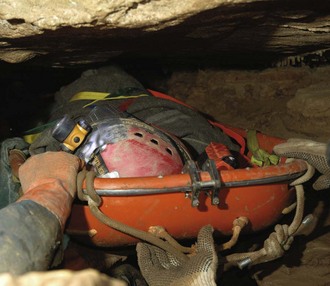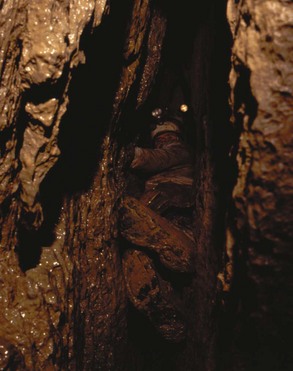Any natural opening in the earth large enough to enter is considered a cave. Caves are similar to human-made mines and tunnels only in that they share a subterranean setting. On a practical level, mines and tunnels must be approached with skills, equipment, and training that differ from those for caves. This chapter addresses only natural caves such as may be found in a wilderness environment, not their dissimilar human-made counterparts.
Caves take many forms, including sinkholes, cracks, sumps, siphons, springs, pits, and caverns. The precise geology of cave formation is a more complex and diverse topic than can be adequately addressed within the confines of this chapter. Some caves are simply topographic in nature—cracks and fissures that are a natural result of typical geologic features. Included in this category are lava tubes, which form when a volcano erupts and lava flows away from its center. Gases create bubbles in the molten rock, leaving voids as it hardens. Lava tube caves form as flowing lava cools hard on the outside and continues to flow on the inside, leaving a “tube” of passage. Like most caves that are formed as a result of earthen upheaval and movement, lava tubes are unpredictable and may run for long distances or be limited to short passages and isolated rooms.
More interesting is the geology of caves that form over long periods of time. An oversimplification of this formation process is that caves—particularly limestone caves, but in truth any cave found in carbonic rock—are most often formed as a result of solution reaction between water, carbon dioxide, and the rock. Known as karst, such topography is formed when carbon dioxide and water combine to form weak “carbonic acid,” which in turn dissolves the carbonic rock. This process is most commonly found in limestone areas.
As the limestone dissolves, the acid solution follows the path of least resistance through the earth, and eventually pits are formed, then fissures, and eventually passages. When the calcium carbonate–infused water reaches a large enough opening, the carbon dioxide dissipates and the calcium carbonate is deposited as stalagmites (icicle-like columns protruding from the ground) and stalactites (icicle-like columns hanging from cave ceiling).
Sumps, siphons, and springs are all names that describe specific features in water-based cave formations. Springs, which are outflows of water from the earth, are obvious access points between underground passage and the surface, but they can be called a cave only when they are large enough for a person to enter.
Springs differ from siphons in that springs outflow water, whereas siphons take in water. Air-filled cave passages that terminate in water-filled passages are known as sumps. Some sumps are only a few feet long before returning to air-filled sections; others can be thousands of feet in length and may never resurface.
Sinkholes, cracks, pits, and caverns are terms that describe passages. These may be wet or dry and are differentiated by their shapes and attributes. Sinkholes, also called sinks, are formed when bedrock above a void collapses. Sinks may manifest as a sheer vertical opening into a cave with a well-like or open-air pit entrance, a steep sloping depression with a cave entrance, or a shallow depression of many acres that may not have more than a small, impassable sump to the cave below.
Cracks are narrow vertical passages formed as the carbonic acid solution finds its way through the ground. These are usually, but not always, developed along a joint in the rock.
The term pit refers to a vertical cave passage. Pits can be found both inside caves and at the surface. Most open-air pits form when the roof of a sinkhole collapses. Pits can also be formed by solution reaction or erosion of passage by flowing water.
Solution caves formed in soluble rock are the most common type found on Earth. Depending on local weather conditions and length of time, caves can take up to tens of thousands of years to form to the point where humans can enter. Caves are always getting either larger through solution and erosion or smaller by filling in with sand, mud, and fallen rock. These changes usually happen so slowly that they are seldom noticeable.
Most cave ceilings and walls are relatively stable. Large breakdown blocks of fallen ceiling and wall rock are often found in caves, but the chances of rock falling precipitously are slim. Breakdown usually occurs suddenly as a result of a major environmental event, such as an earthquake, or very slowly over years as the supporting rock below slowly degrades. Smaller rocks and rock slopes, often the results of ceiling and wall breakdown, are actually the greatest dangers in caves. Because they have not been stabilized by frequent travel, these slopes can shift and slide underfoot.
The continuous conduit leading through a cave is known as a passage. Passages can be huge, with room dimensions so large it is difficult to see distant walls (Figure 46-2) even with a light, whereas just around the next corner, the passage can change to tight impenetrable cracks or a dead end (Figure 46-3). Some cave passages wander around in a maze-like pattern that may total many miles in an area as small as a few acres of ground. Other caves may go for miles in the same direction and contain dozens of miles of passage. Many caves are only a few hundred feet long and have only low, tight, belly-crawl passage. A passage that opens into a wide area is called a room, whereas a tight, narrow passage may be further described as a squeeze or crawl.
Caves are formidable, dark, and often dangerous for the unprepared. Considering that running, seeping, or standing water originally formed most caves, it is not surprising that water is a major part of many cave environments. Cavers and rescuers must be prepared to negotiate anything from crawls in water-filled tubes (Figure 46-4) to underground rivers so large that a boat is required.
Caves that are no longer hydrologically active are called dry caves or dead caves because they are no longer in their formative state. Some caves are so dry that dust induces respiratory problems in cavers. Visitors to dusty caves should wear appropriate filter masks as a minimum level of protection from dust stirred up by the act of moving through a dry passage.
Temperature extremes are another common characteristic of caves. Caves tend to be at the mean ground temperature of the area. For the most part, U.S. continental caves run from cool to cold. Very warm climates, such as in Puerto Rico, sport warm caves, whereas alpine mountain caves in locations such as Montana measure close to freezing temperatures and may even contain ice. Caves found in tropical and desert environments can be so hot that cavers must wear lightweight garments to explore them—even then, these cavers are at risk for heat illness.
A common scenario in cave rescue is the concern for hypothermia. Most caves are cool to cold, but temperature differentials can exist within a single cave, depending on exposure, orientation, and water flow. Temperature differentials or pressure differences can result in winds flowing through cave passages. It is not uncommon for a caver to be supine or prone in 4 inches (1.6 cm) of 13° C (55° F) water with his or her back pressed against cold rock, facing a stiff breeze (Figure 46-5).
If not prevented, hypothermia will complicate any cave incident. An injured, less mobile person will not generate as much heat as usual in the cold, frequently wet cave environment. Party members and rescuers must work to prevent hypothermia as soon as any injury occurs.
Rescuers must also protect themselves from hypothermia. A common scenario is for a rescuer to carry a load of heavy gear rapidly through the cave, then sit in a cold, wet passage to wait for the next assignment. The sweaty rescuer is now subject to evaporative, conductive, and convective heat loss. The well-prepared rescuer dresses in layers, travels light, and adds or removes layers of clothing as needed.
Caves can be fragile, often heavily decorated with mineral formations that have developed over thousands of years. Cavers try to protect these formations whenever possible by avoiding walking on or touching delicate areas or otherwise altering the cave. Even natural skin oils deposited by human hands can alter the growth of an active formation. The caver’s motto, “leave nothing but footprints, take nothing but pictures, and kill nothing but time,” extends to rescue operations. Everything brought in must be packed out at the end of the operation. An abandoned flashlight battery can leach its chemicals and poison cave-adapted life forms, ultimately destroying the cave and its environment.













